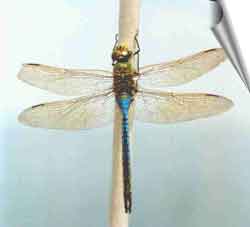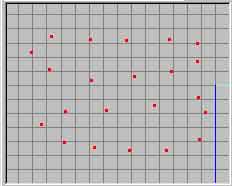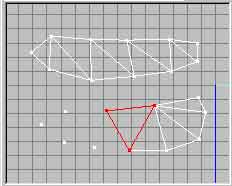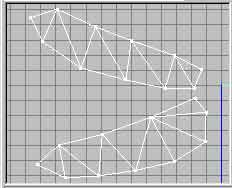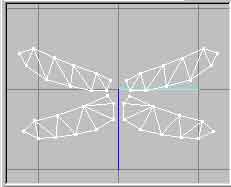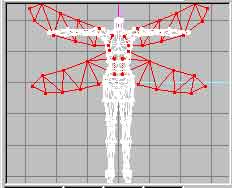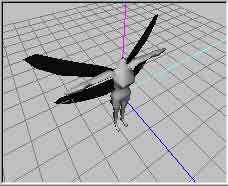TheSims Skins Tutorial
Mesh
My first step is always to find a picture of what I'm modelling. How you do this is up to you, and beyond the scope of the tutorial.
Fossils of prehistoric dragonflies have been found with wingspans of 30 inches and body lengths up to 18 inches.
The next step is to create the mesh. A mesh is a group of vertices and faces. However you wish to create it is fine, but it MUST be a mesh when you're done. No splines, no curves. Just vertices and faces.
Tip: Vertices are points in 3d space. (The red dots in the picture below) Vertices is the plural of vertex.
I'm going to use MilkShape3D to create my mesh. I do it the old-fashioned way. I create a bunch of vertices and then connect them together.
These are the left wings as you look down on them. Are they perfect? No. It's not time for perfection. If you get the vertices in approximately the right spots, you've done well.
Next, we connect the vertices to make faces (triangles). It doesn't matter how you connect them, just don't overlap the triangles.
MS3D: To make a face in MS3D, select Face from the menu on the Right, then click 3 vertices in order.
Faces are 1-sided. If you connect them counter-clockwise, they face you. If you connect them clockwise, they face away from you. To have them face both way, you connect them twice, once each way. Our wings are flat and 2-sided, so we're going to connect both ways.
Tip: To make it easier to remember to go counter-clockwise, I never connect clockwise. Instead, I turn the mesh upside down and go counter-clockwise.
MS3D: To make it easier to tell if you missed some faces, right-click on the perspective (3d) viewport and un-check 'Draw Backfaces'. Now, the only faces that show in the view are the ones that are facing the camera (you).
I got lucky, and my vertices were placed correctly the first time. If they had not been, I would now move them around individually until I've got them the way I want them.
Even though it's not realistic, I want my wings to be spread apart. Here, I've rotated them to the way I want.
Adults of Odonata can fly backwards or forwards and even hover like a helicopter. They can do these incredible aerial tricks because their two pairs of wings move independently of each other, in contrast to most other insects
Next, we need to create the right wings. Here, I simply exported the left wings, flipped the vertices on the screen left<->right (making them the right wings) and imported the left wings again.
MS3D: To flip vertices, select the vertices you want flipped and then choose Mirror Left<->Right from the Vertex Menu.
MS3D: When your faces are not 2-sided, they are all inverted when flipped. To fix this, select all the faces and 'Reverse Vertex Order' from the faces menu.
Next, we would add the texturing. These wings are simple enough that we can skip this step for now, though. Texturing is covered in the next chapter.
Next, we need to resize, rotate, and modify the wings to fit a body mesh properly.
The next, we position them correctly.
Here, I have scaled them down to size, rotated them so they are at a good angle, moved them closer to each other, and finally moved them up against the body.
Note: Do NOT move or rotate the body. Only modify the objects you are creating/modifying.
The final step is to remove the body (Because it's not part of the wings) and then export the wings as an OBJ.
Note: It's best to use the intended body as the dummy body because it will guarantee a good fit. See the 3rd chapter for information on converting SKNs to OBJ.
MS3D: MS3D v1.3.2 has a bug. When exporting an OBJ, it gives it the extension .3DS Just allow it to give it that extension, then manually change it in Explorer.
Mating of dragonflies and damselflies is peculiar in that the mate holds the female behind the head while the female receives the male reproductive cells. Mating pairs will stay clasped for several hours, even flying while joined together.
Maxis and TheSims are Copyright 2000 to Electronic Arts.
All items on this site are Copyright © 2000 - 2004 SimGallery and/or Kelahn.com
